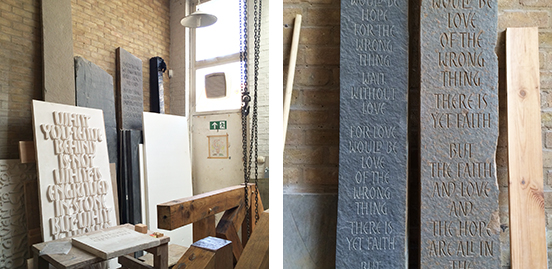19.09.2015
THE EXPERIMENTS OF RICHARD KINDERSLEY
Many years ago I had the good fortune to visit the Cardozo Kindersley letter-cutting workshop in Cambridge. On arrival, Linda Cardozo immediately exchanged her hammer and chisel for the tea pot and biscuits. The afternoon was spent chatting about letter-cutting techniques, listening to anecdotal stories about her late husband David Kindersley, and admiring the most vigorous letters inscribed into solid blocks of stone. Enchanted by the conviviality of the letter-cutting fraternity and dazzled by their achievements, I left thinking that I had perhaps found a calling a little too late in my life.
Letter-cutting is clearly a vocation, and one that you have to start early. At the age of 18 David Kindersley read the books of Eric Gill and made up his mind to become his apprentice. When he had learnt all he could from his master, David set up his own workshop in Cambridge and experimented with a thoughtful and rhetorical approach to lettering.

One of the later projects completed by the David Kindersley and Linda Cardozo partnership is the huge entrance gate at the British Library. This screen of steel letters protects the public entrance to the largest library in the world. It never fails to lift my spirits when I pass through the open gates.
David Kindersley also trained his son Richard whilst in his Cambridge workshop. Recently we were asked to recommend a letter-cutter for a project at the British Museum. We discovered that quite by chance, we were Richards's near-neighbours and so an invitation to visit his South London workshop was arranged.




Our Atelier group were received with the same Kindersley welcome; Richard handed us all mugs of strong tea before taking us into his purpose built workshops. First was his studio, a double-height single room bathed in light from a large north-facing window. Over forty years of experimenting adorn the walls, sit on the floor, or languish hidden in dark corners. A jumble of steel, slate, bronze, concrete, and stone samples surrounded a large central table on which work-in-progress paperwork and sketches lay. A large drawing board stood next to a grant enlarger. Evidently, everything was still done by hand here. We were standing in a sanctum for typographic investigation.

Richard was generously forthcoming, pulling out samples from behind stacks, and lifting them up onto his impromptu show table. He traced his letters with his forefinger while recounting the stories of each piece. They seem like cherished progeny; every sample had a genesis and explored a new technique that made it one of a kind. After selected members of the brood had been shown, each was carefully returned to its allotted place in the hideaway.
It was surprising to find Richard making letters from polystyrene — probably the most uninspired material imaginable — yet he used a hot-wire and cut a series of slithers to build a letter, carefully arranged each letter to create the words, then from the assemblage he made a mould, and finally cast the piece in concrete. The result is remarkably expressive. Perhaps this is the captivating skill of the Kindersleys, their ability to bring to life the most inert of materials.

Our visit ended in the cutting workshop, with heavy-duty lifting chains hanging from an overhead beam, and unfeasibly tall standing stones propped against a wall. Two shards of warm grey Caithness stone were inscribed with passages by TS Eliot. Measuring about 30cm wide and reaching nearly 5 meters in height, they look as if they should snap in half. Richard unassumingly revealed his geological knowledge, explaining that the stones had a lateral strength, making Caithness stone ideal for such a slender form. With a restrained pleasure, he described the thrill of watching the stone being split, exposing a surface layer that had not seen daylight for 240 million years. He feels very privileged to be the first set of eyes to look so far back in time.
After a thank you pub lunch our Atelier group said farewell. Richard returned to his hammer and chisel, polystyrene and concrete. We returned to our keyboards and screens. There was a great span of time in the techniques used by both our studios but we share a common curiosity with 26 letters. Our morning had been a precious opportunity to touch a typographic lineage that ran back from Richard Kindersley, through his father David, to Eric Gill, and on to Edward Johnston who had taught Gill. It was reassuring to find that the letter-cutting fraternity was still quietly going about its work in South London, as it is in his father's workshop in Cambridge. The apprenticeship system that passed on the skills and fostered the lineage of experimentation is still at the heart of both workshops. But, I wondered, how many 18 year-olds would know today that letter-cutting was their vocation?
Ian Chilvers
![]()